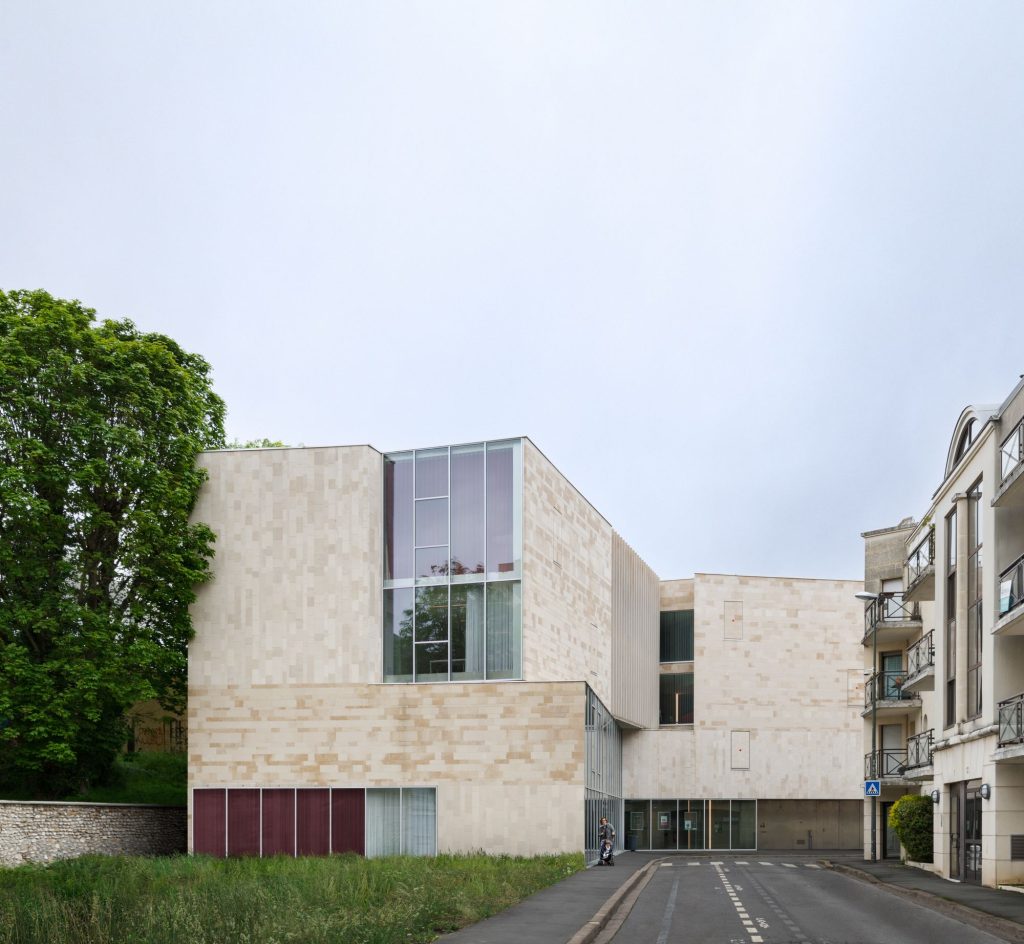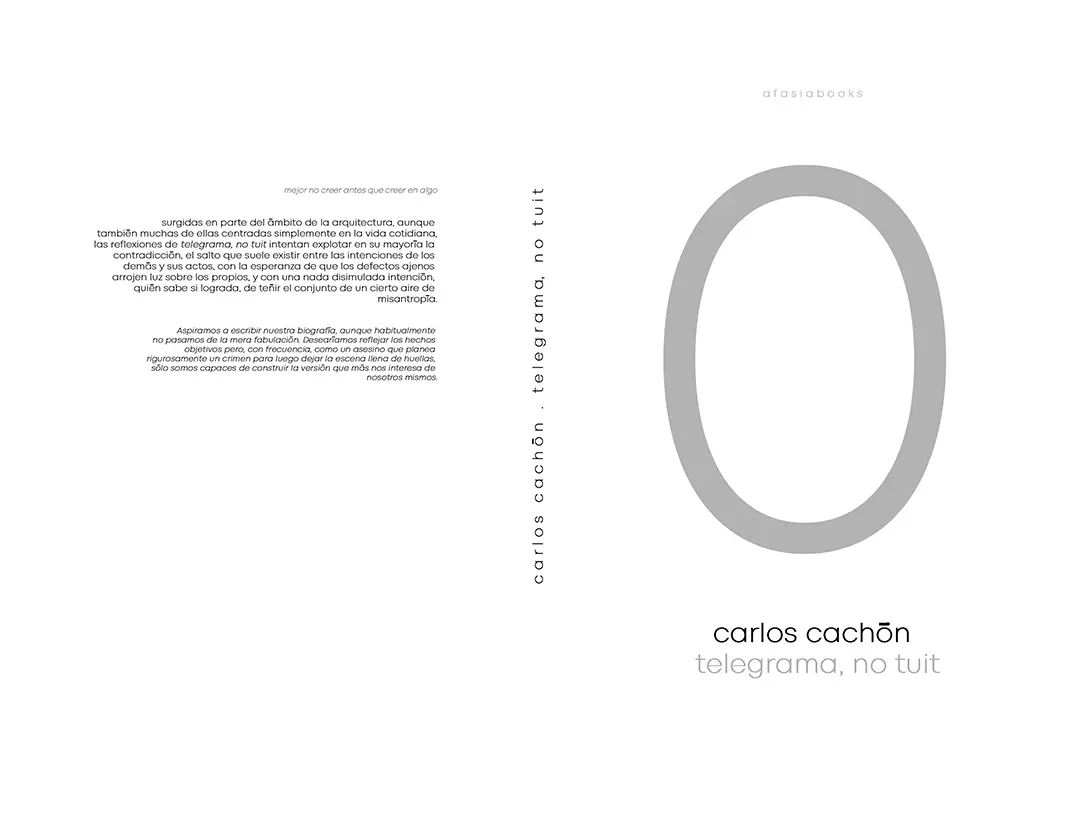
Dominique Coulon & Associés . photos: © Eugeni Pons
The Cultural Centre in Bourg-la-Reine lies on a narrow plot right next to a high embankment upon which a regional trainline runs. This plot is L-shaped and leads out onto a small road hidden away. To build a public centre, such a plot seemed far from ideal.
So building an edifice on this plot called for a design with which the structure could stand out as a public building and find a legitimate place between the vegetation-covered embankment and the neighbouring homes.
The watchword in this programme was connection. Indeed, we had to relate many spaces with highly varied purposes to each other. These spaces included a 250-seater theatre and its dressing rooms, two dance studios, rooms devoted to languages and music, an exhibition space, rooms for adolescents and activities for parents and children, workshops for stringed instruments and visual arts, a learning kitchen, a bar and, lastly, an administrative hub.
For us, a programme as rich and as quality-oriented as this one had to find spatial expression worthy of it.
So we paid particular attention to the quality of the collective spaces. In doing so, we placed the building’s entrance hall in the curve of the road so that the edifice’s two sections, following the plot’s shape, would join in an open space that would encourage encounters while offering views of the adjacent vegetation through glazing.
The open spaces implicitly join the different rooms together to make them relate to each other better. The strangeness of the plot’s geometry prompted us to create an arrangement of oblique forms and folds that intertwine.
The spaces interweave into each other and the elevations reflect this. Inside, a vast open space expands through three levels of the building, multiplying double heights, viewpoints, walkways and suspended spaces. This unifying area is like a point of reference at the heart of the project. The hall’s triple height captures sunlight, in spite of the embankment. It offers large-framed vistas of the sky and trees from its hallways, its upstairs walkways and its first-floor meet-up space.
The scale of the windows across the facade give the building its public edifice status. These windows create hollows in the limestone structure and put the project’s spatial and programmatic wealth on display. The huge windows reveal the programme’s generosity and suggest a project bathed in natural light and embellished with vegetation, crisscrossing views and unique atmospheres.
_
Contracting owner: Bourg-la-Reine Town Council
Project manager: Dominique Coulon & Associés
Architect: Dominique Coulon
Project supervision: Lukas Unbekandt
Assistants: Fanny Liénart, Alexandre Puech
Worksite supervision: Lukas Unbekandt, Mehmet Davaz
Engineering consulting firm (Structure): Batiserf Ingénierie
Engineering consulting firm (Electricity and IT Security): BET Gilbert Jost
Engineering consulting firm (Fluids): Solares Bauen
Scenographic design: Euro Sound Project
Economics: E3 Économie
Acoustics: Euro Sound Project
Programme: Multipurpose theatre with tiered seating, creative arts rooms, stringed instrument workshop, science and technology room, craft rooms, multimedia room, language room, dance studios, music studios, exhibition space, entrance hall, learning kitchen and administrative offices.
Location: 11 rue des Rosiers, 92340 Bourg-la-Reine, France
Google Maps location: N 48°47’0.337 E 2°18’47.566
Floor area: 2,550m² (adjusted gross floor area) / 1,667m² (usable floor area) / 2,149m² (net floor area)
Cost: €6,082,981 excl. VAT
Schedule:
Competition: April 2016
Studies: September 2016 to February 2018
Project execution: April 2018 to July 2023
Handover: July 2023
Firms:
Landscaping: SPTP & TP – General earthworks, structural works and metal frameworks: LBC –Watertightness: AXE ÉTANCHÉITÉ – External metalwork: BARBIER – Locks: EDE – Stone cladding, external insulation, external paintwork and external suspended ceilings: DBPM – External scaffolding: CIREME – Plasterwork and suspending ceilings: LES PLÂTRES MODERNES C. JOBIN – Indoor joinery, furniture, wood strip flooring and kitchen: HUNSINGER – Screeds: TECHNOPOSE ET BEDEL – Glued-down floors: TECHNOPOSE ET BEDEL – Tiling: TECHNOPOSE ET BEDEL – Indoor paintwork and cleaning: ART MANIAC – Lift: ALMA – Photovoltaics and electrics (strong and weak currents): SATELEC – Heating and ventilation: ROGER RENARD – Plumbing and sanitary installations: SERT – Machinery and stage fabrics: SN LEBLANC SCENIQUE – Sound system and audiovisual technology: D6BELL – Tiered seating and seats: SAMIA DEVIANNE – Office and workshop furniture: ALDEO – Relaxation furniture: ALDEO
Photography: Eugeni Pons
Le centre culturel s’inscrit dans une parcelle très étroite adossée à un grand talus sur lequel passe le RER. La forme en « L » de ce terrain donnant sur une petite rue confidentielle semblait loin d’être idéale pour construire un équipement public. Construire ici impliquait un dispositif permettant au bâtiment de s’affirmer en tant que bâtiment public et de trouver sa place entre le talus végétalisé et les logements voisins. Le maître-mot du programme a été la connexion, car il s’agissait de mettre en relation de nombreux espaces aux fonctions très variées : une salle de spectacle de 250 places et ses loges, deux salles de danse, des salles consacrées aux langues et à la musique, un espace d’exposition, des locaux dédiés aux adolescents et aux activités parents/enfants, des ateliers de lutherie et d’arts plastiques, une cuisine pédagogique, un bar, et pour finir, un pôle administratif. Un programme aussi riche et qualitatif devait selon nous bénéficier d’une traduction spatiale qui serait son égale. Nous avons donc porté une attention particulière à la qualité des espaces collectifs, et pour se faire, positionné l’entrée du bâtiment dans la courbure de la rue de façon à ce que les deux volumes du bâtiment, épousant la forme du terrain, s’articulent autour d’un vide qui invite à la rencontre tout en offrant des transparences vers la végétation environnante. Les vides articulent en creux les différents espaces pour mieux les mettre en relation. L’étrangeté géométrique de la parcelle nous a conduits à installer un jeu d’obliques et de plis qui s’entrelacent. Les volumes s’imbriquent les uns dans les autres et les façades s’en font l’écho. À l’intérieur, le grand volume vide se dilate sur tous les niveaux du bâtiment, multipliant les doubles hauteurs, points de vue, coursives et volumes suspendus. Cet espace fédérateur fonctionne comme un repère au cœur du projet. La triple hauteur du hall permet de capter la lumière du soleil malgré la présence du talus. Elle offre un grand cadrage sur le ciel et les arbres depuis les espaces de circulation, les coursives des étages et l’espace de rencontre du R+1. L’échelle des ouvertures en façade confère au bâtiment son statut d’édifice public. Elles fabriquent des creux dans ce volume minéral de pierre calcaire, qui donnent à voir la richesse spatiale et programmatique du projet. Les grandes ouvertures révèlent la générosité du programme et laissent deviner un projet baigné de lumière, de végétation, de vues croisées et d’ambiances singulières.












































